View in other NatureServe Network Field Guides
NatureServe
Montana
Utah
Wyoming
Idaho
Wisconsin
British Columbia
South Carolina
Yukon
California
New York
Northern Spikemoss - Selaginella selaginoides
State Rank Reason (see State Rank above)
Rare in Montana, where it is known from a few occurrences from the southwest portion of the state. Little survey data are available for known occurrences.
General Description
Low Spike-moss is a low, moss-like, glabrous plant with branched, prostrate to ascending stems. The thin, narrowly lance-shaped leaves are 1-3 mm long, are spirally arranged on the stem, and have sparsely spine-toothed margins. The upper leaves of fertile stems are larger, more broadly lance-shaped, and bear in their axils 1 to a few spores that are ca. 0.5 mm across.
Phenology
Mature sporophylls in late July.
Diagnostic Characteristics
Other species of Selaginella occur in dry habitats and have thicker, bristle-tipped leaves. Species of Lycopodium have thicker leaves without spine-like teeth on the margins. A hand lens will be necessary for positive identification.
Species Range
Montana Range
Range Descriptions
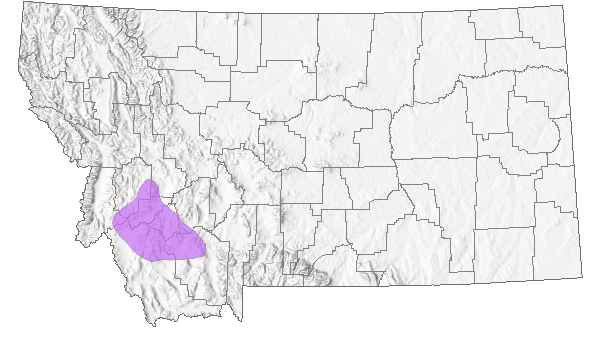
 Native
Native
Range Comments
In MT in Granite, Beaverhead, Silver Bow, and Madison counties; circumboreal, south in North America to BC, NV, WY, MI, and NS.
Observations in Montana Natural Heritage Program Database
Number of Observations: 21
(Click on the following maps and charts to see full sized version)
Map Help and Descriptions
Relative Density
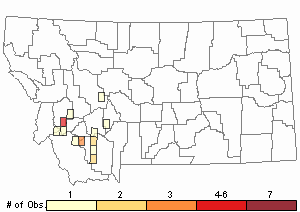
Recency

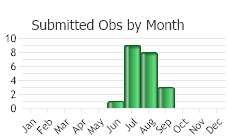
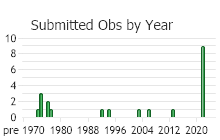
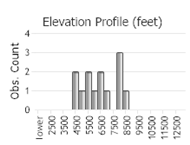 (Observations spanning multiple months or years are excluded from time charts)
(Observations spanning multiple months or years are excluded from time charts)
Habitat
Wet, mossy soil of seep areas and moss-covered soil of meadows and rock outcrops in the montane and subalpine zones.
Threats or Limiting Factors
STATE THREAT SCORE REASON
Threat impact not assigned because threats are not known (MTNHP Threat Assessment 2021).
References
- Additional ReferencesLegend:
 View Online Publication
View Online Publication
Do you know of a citation we're missing? Achuff, P. L. and L. S. Roe. 1992. Botanical survey of the Goat Flat proposed Research Natural Area, Deerlodge National Forest. Unpublished report to the Deerlodge National Forest. Montana Natural Heritage Program, Helena, MT. 31 pp.
Achuff, P. L. and L. S. Roe. 1992. Botanical survey of the Goat Flat proposed Research Natural Area, Deerlodge National Forest. Unpublished report to the Deerlodge National Forest. Montana Natural Heritage Program, Helena, MT. 31 pp. Heusser, C.J. 1994. Quaternary migration pattern of Selaginella selaginoides in the North Pacific. Arctic and Alpine Research 26(2):187-192.
Heusser, C.J. 1994. Quaternary migration pattern of Selaginella selaginoides in the North Pacific. Arctic and Alpine Research 26(2):187-192. Lackschewitz, K. H. 1976. Montana mountain flora: new records. Madrono 23:360-362.
Lackschewitz, K. H. 1976. Montana mountain flora: new records. Madrono 23:360-362. Lellinger, D.B. 1985. A Field Manual of the Ferns and Fern-Allies of the United States and Canada. Smithsonian Inst. Press. Washington, D.C. B85LEL01PAUS
Lellinger, D.B. 1985. A Field Manual of the Ferns and Fern-Allies of the United States and Canada. Smithsonian Inst. Press. Washington, D.C. B85LEL01PAUS Lesica, P., M.T. Lavin, and P.F. Stickney. 2012. Manual of Montana Vascular Plants. Fort Worth, TX: BRIT Press. viii + 771 p.
Lesica, P., M.T. Lavin, and P.F. Stickney. 2012. Manual of Montana Vascular Plants. Fort Worth, TX: BRIT Press. viii + 771 p. Lesica, P., M.T. Lavin, and P.F. Stickney. 2022. Manual of Montana Vascular Plants, Second Edition. Fort Worth, TX: BRIT Press. viii + 779 p.
Lesica, P., M.T. Lavin, and P.F. Stickney. 2022. Manual of Montana Vascular Plants, Second Edition. Fort Worth, TX: BRIT Press. viii + 779 p. Miller, N. G. 1990. The management of rare plants: suggestions derived from palecological studies of late-Pleistocene floras. Pp. 159-162 in: Mitchell, S., C. J. Sheviak and D. J. Leopold (eds). Ecosystem management: rare species and significant habitats. Proceedings of the 15th annual Natural Areas Conference. New York State Museum Bulletin 471.
Miller, N. G. 1990. The management of rare plants: suggestions derived from palecological studies of late-Pleistocene floras. Pp. 159-162 in: Mitchell, S., C. J. Sheviak and D. J. Leopold (eds). Ecosystem management: rare species and significant habitats. Proceedings of the 15th annual Natural Areas Conference. New York State Museum Bulletin 471. Vanderhorst, J.P. and B.L. Heidel. 1995. Sensitive plant survey in the Tobacco Root Mountains, Madison County, Montana. Unpublished report to the Beaverhead and Deerlodge National Forests. Montana Natural Heritage Program. Helena, MT. 66 pp. plus appendices.
Vanderhorst, J.P. and B.L. Heidel. 1995. Sensitive plant survey in the Tobacco Root Mountains, Madison County, Montana. Unpublished report to the Beaverhead and Deerlodge National Forests. Montana Natural Heritage Program. Helena, MT. 66 pp. plus appendices.
- Web Search Engines for Articles on "Northern Spikemoss"





